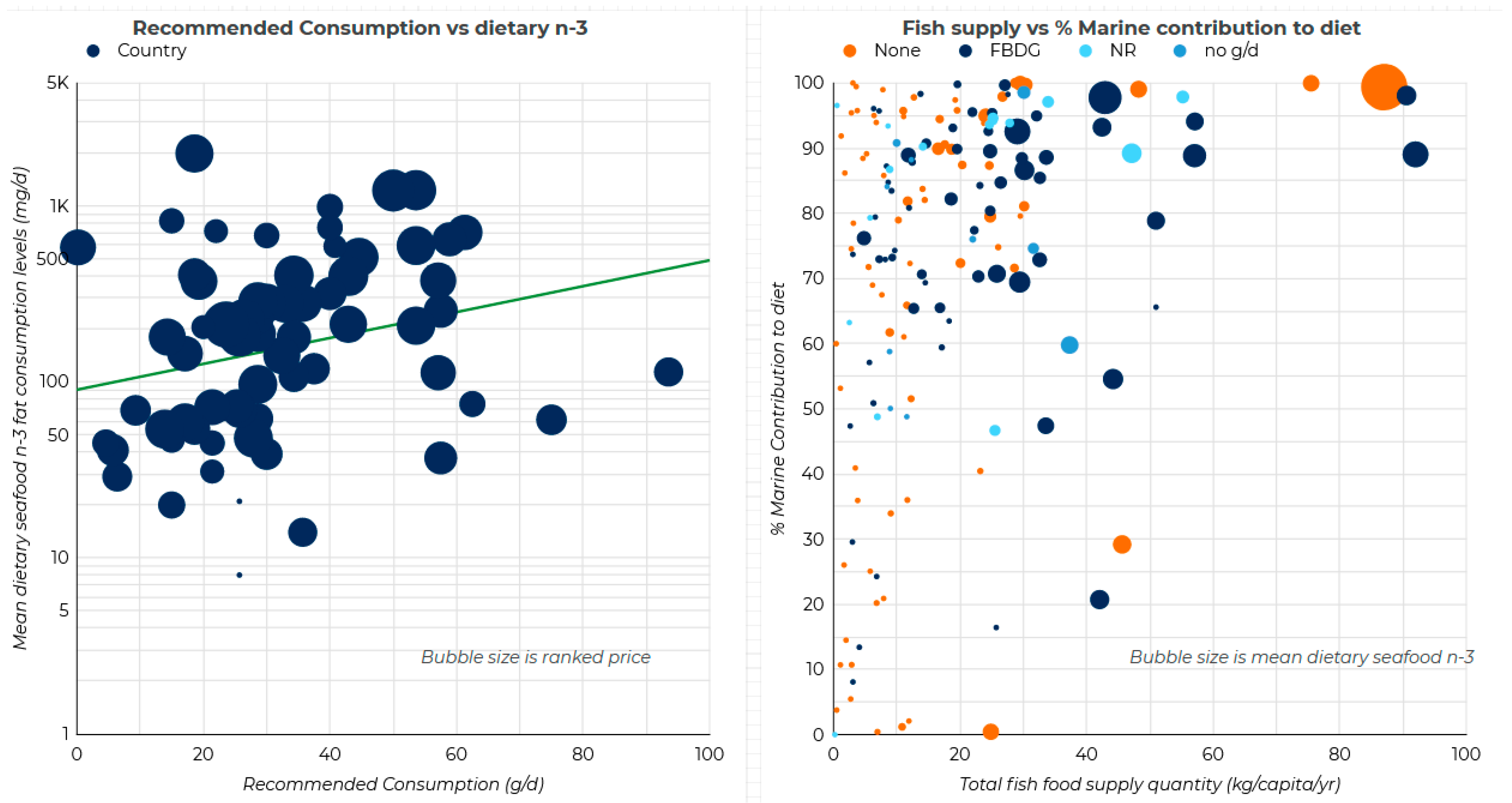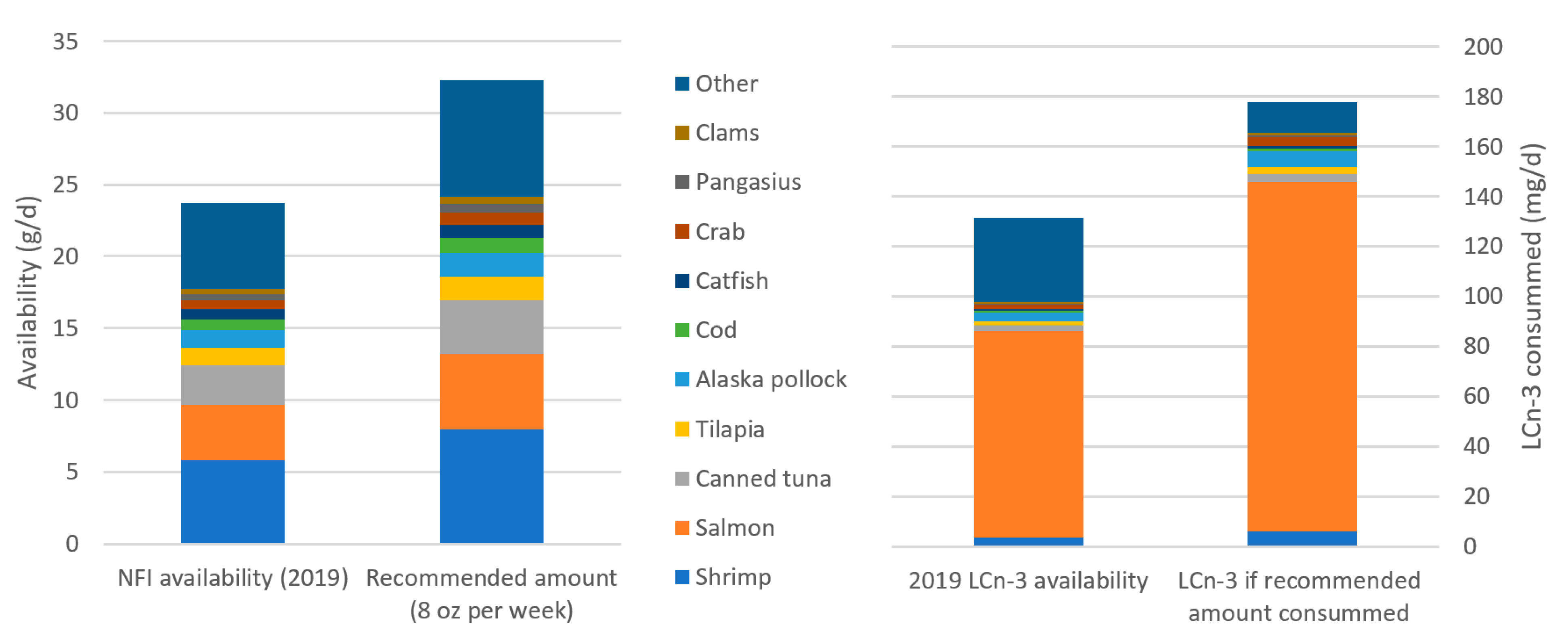Food-Based Dietary Guidelines for Seafood Do Not Translate into Increased Long-Chain Omega-3 Levels in the Diet for U.S. Consumers
Abstract
:1. Introduction
- -
- -
- -
- -
- Consuming oily fish multiple times per week along with ingesting supplements results in the highest index of the percentage of LCn-3 as a percentage of total erythrocyte fatty acids [36].
2. Materials and Methods
3. Results
4. Discussion
Funding
Institutional Review Board Statement
Informed Consent Statement
Data Availability Statement
Acknowledgments
Conflicts of Interest
References
- FAO. The State of World Fisheries and Aquaculture 2020. Sustainability in Action; FAO: Rome, Italy, 2020. [Google Scholar]
- Tacon, A.G.J.; Metian, M. Fish Matters: Importance of Aquatic Foods in Human Nutrition and Global Food Supply. Rev. Fish. Sci. 2013, 21, 22–38. [Google Scholar] [CrossRef]
- Hicks, C.C.; Cohen, P.J.; Graham, N.A.J.; Nash, K.L.; Allison, E.H.; Lima, C.D.; Mills, D.J.; Roscher, M.; Thilsted, S.H.; Thorne-lyman, A.L.; et al. Harnessing global fisheries to tackle micronutrient deficiencies. Nature 2019, 574, 95–98. [Google Scholar] [CrossRef] [Green Version]
- Béné, C.; Barange, M.; Subasinghe, R.; Pinstrup-Andersen, P.; Merino, G.; Hemre, G.I.; Williams, M. Feeding 9 billion by 2050—Putting fish back on the menu. Food Secur. 2015, 7, 261–274. [Google Scholar] [CrossRef] [Green Version]
- OECD/FAO. OECD-FAO Agricultural Outlook 2020–2029; OECD-FAO Agricultural Outlook; FAO Publishing: Rome, Italy; OECD Publishing: Paris, France, 2020; ISBN 9789264317673. [Google Scholar]
- Gardner, C. “Instead of what,” and repeated 4-year interval change regarding red meat and T2D: Increasing causal inference in nutritional epidemiology through methodological advances. Am. J. Clin. Nutr. 2021, 113, 497–498. [Google Scholar] [CrossRef]
- Bird, J.K.; Murphy, R.A.; Ciappio, E.D.; McBurney, M.I. Risk of deficiency in multiple concurrent micronutrients in children and adults in the United States. Nutrients 2017, 9, 655. [Google Scholar] [CrossRef] [Green Version]
- Lund, E.K. Health benefits of seafood; Is it just the fatty acids? Food Chem. 2013, 140, 413–420. [Google Scholar] [CrossRef]
- Papanikolaou, Y.; Brooks, J.; Reider, C.; Fulgoni, V.L. U.S. adults are not meeting recommended levels for fish and omega-3 fatty acid intake: Results of an analysis using observational data from NHANES 2003–2008. Nutr. J. 2014, 13, 31. [Google Scholar] [CrossRef] [PubMed] [Green Version]
- Spiller, P.; Hibbeln, J.R.; Myers, G.; Vannice, G.; Golding, J.; Crawford, M.A.; Strain, J.J.; Connor, S.L.; Brenna, J.T.; Kris-Etherton, P. An abundance of seafood consumption studies presents new opportunities to evaluate effects on neurocognitive development. Prostaglandins Leukot. Essent. Fat. Acids 2019, 151, 8–13. [Google Scholar] [CrossRef] [Green Version]
- Hibbeln, J.R. Depression, suicide and deficiencies of omega-3 essential fatty acids in modern diets. World Rev. Nutr. Diet. 2009, 99, 17–30. [Google Scholar] [CrossRef]
- Hibbeln, J.R.; Davis, J.M.; Steer, C.; Emmett, P.; Rogers, I.; Williams, C.; Golding, J. Maternal seafood consumption in pregnancy and neurodevelopmental outcomes in childhood (ALSPAC study): An observational cohort study. Lancet 2007, 369, 578–585. [Google Scholar] [CrossRef]
- Harris, W.S.; Tintle, N.L.; Imamura, F.; Qian, F.; Korat, A.V.A.; Marklund, M.; Djoussé, L.; Bassett, J.K.; Carmichael, P.H.; Chen, Y.Y.; et al. Blood n-3 fatty acid levels and total and cause-specific mortality from 17 prospective studies. Nat. Commun. 2021, 12, 2329. [Google Scholar] [CrossRef] [PubMed]
- Kris-Etherton, P.M.; Harris, W.S.; Appel, L.J. Fish consumption, fish oil, omega-3 fatty acids, and cardiovascular disease. Circulation 2002, 106, 2747–2757. [Google Scholar] [CrossRef] [PubMed]
- Harris, W.S. Omega-3 fatty acids. In Encyclopedia of Dietary Supplements; CRC Press: Boca Raton, FL, USA, 2004; pp. 493–504. ISBN 9781482204056. [Google Scholar]
- Gladyshev, M.I.; Sushchik, N.N. Long-chain omega-3 polyunsaturated fatty acids in natural ecosystems and the human diet: Assumptions and challenges. Biomolecules 2019, 9, 485. [Google Scholar] [CrossRef] [Green Version]
- Richter, C.K.; Bowen, K.J.; Mozaffarian, D.; Kris-Etherton, P.M.; Skulas-Ray, A.C. Total Long-Chain n-3 Fatty Acid Intake and Food Sources in the United States Compared to Recommended Intakes: NHANES 2003–2008. Lipids 2017, 52, 917–927. [Google Scholar] [CrossRef] [PubMed]
- Hamilton, H.A.; Newton, R.; Auchterlonie, N.A.; Müller, D.B. Systems approach to quantify the global omega-3 fatty acid cycle. Nat. Food 2020, 1, 59–62. [Google Scholar] [CrossRef] [Green Version]
- Tocher, D.R.; Betancor, M.B.; Sprague, M.; Olsen, R.E.; Napier, J.A. Omega-3 long-chain polyunsaturated fatty acids, EPA and DHA: Bridging the gap between supply and demand. Nutrients 2019, 11, 89. [Google Scholar] [CrossRef] [Green Version]
- Micha, R.; Khatibzadeh, S.; Shi, P.; Fahimi, S.; Lim, S.; Andrews, K.G.; Engell, R.E.; Powles, J.; Ezzati, M.; Mozaffarian, D. Global, regional, and national consumption levels of dietary fats and oils in 1990 and 2010: A systematic analysis including 266 country-specific nutrition surveys. BMJ 2014, 348, g2272. [Google Scholar] [CrossRef] [Green Version]
- Harris, W.S.; Jackson, K.H.; Brenna, J.T.; Rodriguez, J.C.; Tintle, N.L.; Cornish, L. Survey of the erythrocyte EPA+DHA levels in the heart attack/stroke belt. Prostaglandins Leukot. Essent. Fat. Acids 2019, 148, 30–34. [Google Scholar] [CrossRef]
- Love, D.C.; Turvey, C.; Harding, J.; Young, R.; Ramsing, R.; Tlusty, M.F.; Fry, J.P.; Nguyen, L.; Asche, F.; Nussbaumer, E.M.; et al. Nutrition and origin of US chain restaurant seafood. Am. J. Clin. Nutr. 2021, 113, 1546–1555. [Google Scholar] [CrossRef]
- FAO. Food-Based Dietary Guidelines. Available online: http://www.fao.org/nutrition/education/food-dietary-guidelines/en/ (accessed on 20 May 2021).
- Herforth, A.; Arimond, M.; Álvarez-Sánchez, C.; Coates, J.; Christianson, K.; Muehlhoff, E. A Global Review of Food-Based Dietary Guidelines. Adv. Nutr. 2019, 10, 590–605. [Google Scholar] [CrossRef] [PubMed] [Green Version]
- Erve, I.; Tulen, C.B.M.; Jansen, J.; Minnema, R.; Schenk, P.R.; Wolvers, D.; van Rossum, C.T.M.; Verhagen, H. Overview of Elements within National Food-Based Dietary Guidelines. Eur. J. Nutr. Food Saf. 2017, 6, 172–227. [Google Scholar] [CrossRef] [Green Version]
- Graham, E.; Thorne-Lyman, A.L.; Love, D.; Nussbaumer, E.; Bloem, M.; Fry, J.; Pasqualino, M.; Fanzo, J. Food-Based Dietary Guidelines Make Seafood a Priority, Sustainability an Afterthought. Curr. Dev. Nutr. 2020, 4, 139. [Google Scholar] [CrossRef]
- Springmann, M.; Spajic, L.; Clark, M.A.; Poore, J.; Herforth, A.; Webb, P.; Rayner, M.; Scarborough, P. The healthiness and sustainability of national and global food based dietary guidelines: Modelling study. BMJ 2020, 370, 2322. [Google Scholar] [CrossRef]
- FAO. FAOSTAT: New Food Balances. Available online: http://www.fao.org/faostat/en/#data/FBS (accessed on 20 June 2021).
- World Bank. Purchasing Power Parities and the Size of World Economies: Results from the 2017 International Comparison Program; The World Bank: Washington, DC, USA, 2020. [Google Scholar]
- Love, D.C.; Asche, F.; Conrad, Z.; Young, R.; Harding, J.; Nussbaumer, E.M.; Thorne-Lyman, A.L.; Neff, R. Food sources and expenditures for seafood in the United States. Nutrients 2020, 12, 1810. [Google Scholar] [CrossRef]
- U.S. Department of Agriculture and U.S. Department of Health and Human Services. Dietary Guidelines for Americans, 2020–2025, 9th ed.; US Department of Agriculture: Washington, DC, USA, 2020. [Google Scholar]
- Hallström, E.; Bergman, K.; Mifflin, K.; Parker, R.; Tyedmers, P.; Troell, M.; Ziegler, F. Combined climate and nutritional performance of seafoods. J. Clean. Prod. 2019, 230, 402–411. [Google Scholar] [CrossRef]
- Raatz, S.K.; Silverstein, J.T.; Jahns, L.; Picklo, M.J. Issues of fish consumption for cardiovascular disease risk reduction. Nutrients 2013, 5, 1081–1097. [Google Scholar] [CrossRef]
- NFI. NFI’s Top 10 List Suggests Consumers Diversifying Seafood Consumption—About Seafood. Available online: https://aboutseafood.com/press_release/nfis-top-10-list-suggests-consumers-diversifying-seafood-consumption/ (accessed on 20 June 2021).
- National Research Council. A Framework for Assessing Effects of the Food System; The National Academies Press: Washington, DC, USA, 2015. [Google Scholar]
- Jackson, K.H.; Polreis, J.M.; Tintle, N.L.; Kris-Etherton, P.M.; Harris, W.S. Association of reported fish intake and supplementation status with the omega-3 index. Prostaglandins Leukot. Essent. Fat. Acids 2019, 142, 4–10. [Google Scholar] [CrossRef] [PubMed] [Green Version]
- Ervin, R.; Wright, J.; Wang, C.; Kennedy-Stephenson, J. Dietary intake of fats and fatty acids for the United States population: 1999–2000. Adv. Data 2004, 348, 1–6. [Google Scholar]
- World Bank. GDP ranking (GDP)|Data Catalog. Available online: https://datacatalog.worldbank.org/dataset/gdp-ranking (accessed on 20 June 2021).
- Del Gobbo, L.C.; Khatibzadeh, S.; Imamura, F.; Micha, R.; Shi, P.; Smith, M.; Myers, S.S.; Mozaffarian, D. Assessing global dietary habits: A comparison of national estimates from the FAO and the global dietary database. Am. J. Clin. Nutr. 2015, 101, 1038–1046. [Google Scholar] [CrossRef] [PubMed] [Green Version]
- Winkler, J.T. Nutritional survey data are inaccurate. BMJ 2014, 348, g3204. [Google Scholar] [CrossRef] [PubMed]
- Nissen, S.E. U.S. dietary guidelines: An evidence-free zone. Ann. Intern. Med. 2016, 164, 558–559. [Google Scholar] [CrossRef]
- US Department of Agriculture Agricultural Research Service Nutrient Data Laboratory. USDA National Nutrient Database for Standard Reference, Release 28 (Slightly Revised); US Department of Agriculture: Washington, DC, USA, 2016. [Google Scholar]
- Simopoulos, A. The importance of the ratio of omega-6/omega-3 essential fatty acids. Biomed. Pharmacother. 2002, 56, 365–379. [Google Scholar] [CrossRef]
- Tlusty, M.F.; Thorsen, Ø. Claiming seafood is ‘sustainable’ risks limiting improvements. Fish Fish. 2017, 18, 340–346. [Google Scholar] [CrossRef]
- Tuomisto, H.L. Importance of considering environmental sustainability in dietary guidelines. Lancet Planet. Health 2018, 2, e331–e332. [Google Scholar] [CrossRef] [Green Version]
- Godfray, H.C.J.; Aveyard, P.; Garnett, T.; Hall, J.W.; Key, T.J.; Lorimer, J.; Pierrehumbert, R.T.; Scarborough, P.; Springmann, M.; Jebb, S.A. Meat consumption, health, and the environment. Science 2018, 361, eaam5324. [Google Scholar] [CrossRef] [Green Version]
- Philis, G.; Ziegler, F.; Gansel, L.C.; Jansen, M.D.; Gracey, E.O.; Stene, A. Comparing life cycle assessment (LCA) of salmonid aquaculture production systems: Status and perspectives. Sustainability 2019, 11, 2517. [Google Scholar] [CrossRef] [Green Version]
- Tocher, D.R. Omega-3 long-chain polyunsaturated fatty acids and aquaculture in perspective. Aquaculture 2015, 449, 94–107. [Google Scholar] [CrossRef]
- Love, D.C.; Fry, J.P.; Milli, M.C.; Neff, R.A. Wasted seafood in the United States: Quantifying loss from production to consumption and moving toward solutions. Glob. Environ. Chang. 2015, 35, 116–124. [Google Scholar] [CrossRef] [Green Version]
- Love, D.C.; Pinto da Silva, P.; Olson, J.; Fry, J.P.; Clay, P.M. Fisheries, food, and health in the USA: The importance of aligning fisheries and health policies. Agric. Food Secur. 2017, 6, 16. [Google Scholar] [CrossRef] [Green Version]
- Abdelhamid, A.S.; Brown, T.J.; Brainard, J.S.; Biswas, P.; Thorpe, G.C.; Moore, H.J.; Deane, K.H.; AlAbdulghafoor, F.K.; Summerbell, C.D.; Worthington, H.V.; et al. Omega-3 fatty acids for the primary and secondary prevention of cardiovascular disease. Cochrane Database Syst. Rev. 2018, 11. [Google Scholar]
- Visioli, F.; Risé, P.; Barassi, M.C.; Marangoni, F.; Galli, C. Dietary intake of fish vs. formulations leads to higher plasma concentrations of n− 3 fatty acids. Lipids 2003, 38, 415–418. [Google Scholar] [CrossRef] [PubMed]



| Dietary | N-3 | ||
|---|---|---|---|
| Below | Above | ||
| Recommended | Above | 5 | 26 |
| g/d | Below | 19 | 15 |
| FBDG | Above | 36 | 56 |
| Below | 47 | 27 | |
| GDP | Above | 29 | 51 |
| Below | 49 | 31 | |
| Price | Above | 44 | 29 |
| Below | 28 | 45 | |
| Total fish | Above | 16 | 67 |
| Below | 67 | 16 | |
| % Marine Fish | Above | 31 | 52 |
| Below | 52 | 31 |
Publisher’s Note: MDPI stays neutral with regard to jurisdictional claims in published maps and institutional affiliations. |
© 2021 by the author. Licensee MDPI, Basel, Switzerland. This article is an open access article distributed under the terms and conditions of the Creative Commons Attribution (CC BY) license (https://creativecommons.org/licenses/by/4.0/).
Share and Cite
Tlusty, M.F. Food-Based Dietary Guidelines for Seafood Do Not Translate into Increased Long-Chain Omega-3 Levels in the Diet for U.S. Consumers. Foods 2021, 10, 1816. https://doi.org/10.3390/foods10081816
Tlusty MF. Food-Based Dietary Guidelines for Seafood Do Not Translate into Increased Long-Chain Omega-3 Levels in the Diet for U.S. Consumers. Foods. 2021; 10(8):1816. https://doi.org/10.3390/foods10081816
Chicago/Turabian StyleTlusty, Michael F. 2021. "Food-Based Dietary Guidelines for Seafood Do Not Translate into Increased Long-Chain Omega-3 Levels in the Diet for U.S. Consumers" Foods 10, no. 8: 1816. https://doi.org/10.3390/foods10081816
APA StyleTlusty, M. F. (2021). Food-Based Dietary Guidelines for Seafood Do Not Translate into Increased Long-Chain Omega-3 Levels in the Diet for U.S. Consumers. Foods, 10(8), 1816. https://doi.org/10.3390/foods10081816





